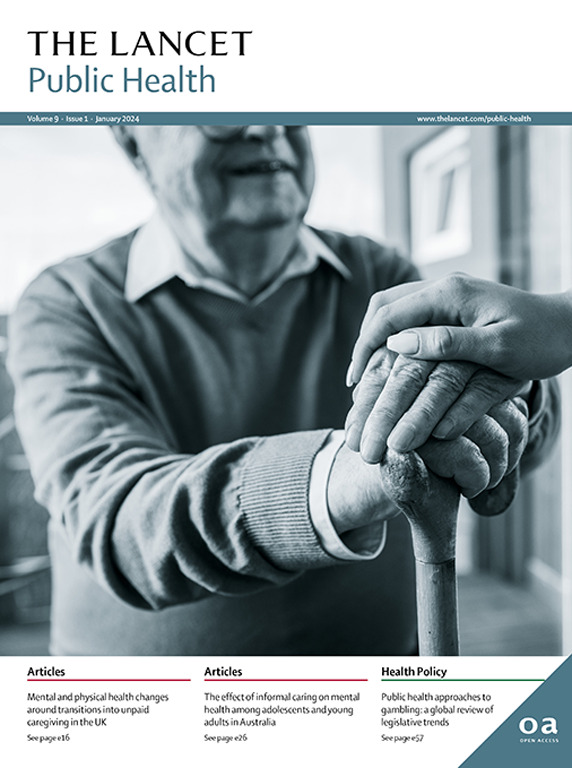丹麦无家可归者和其他高危人群的生命年损失:一项以人口为基础、以登记为基础的队列研究
IF 25.2
1区 医学
Q1 PUBLIC, ENVIRONMENTAL & OCCUPATIONAL HEALTH
引用次数: 0
摘要
无家可归的人有很高的死亡风险。对绝对风险的估计,如生命年损失,比传统的预期寿命估计更准确地衡量了流动人口的死亡率差异,并能够与一般人口和其他高风险人口进行直接比较。我们的目的是按性别、年龄组和死亡原因检查无家可归者和其他高危人群的死亡风险和寿命损失。方法:我们在2002年1月1日至2020年12月31日期间对居住在丹麦的17-100岁人群进行了一项全国性的、基于登记册的队列研究。来自丹麦民事登记系统的数据与无家可归者登记册和死亡原因登记册相关联。结果是随访期间的总死亡率和原因特异性死亡率。我们使用泊松回归分析估计了每10000人年的危险死亡率,并估计了校正死亡率。我们计算了无家可归者的平均寿命和特定年龄的预期寿命以及寿命损失,并将这些数据与一般人群以及患有精神分裂症、酒精使用障碍和药物使用障碍的个体进行了比较。在6 286 512名丹麦居民中,58 376人(0.9%)在研究期间至少与一个无家可归者收容所有过接触。在有无家可归史的人群中,死亡率为每1万人年240·3(95%可信区间为236·3 - 244·4)。在无无家可归史的普通人群中,每10000人年的死亡率为117·8 (95% CI为117·6-118·1),与无无家可归史的普通人群的绝对差异为122·5(118·5 - 126·5)。与一般人群相比,男性的平均额外生命年损失为15.9 (95% CI为15.8 - 16.2),女性为15.3(14.8 - 15.7),高于其他高危人群,如精神分裂症、酒精使用障碍和药物使用障碍(有或没有无家可归史)的人群。无家可归者的超额死亡率大部分归因于外部死亡原因、精神疾病以及肝脏和消化系统疾病。与一般人群相比,男性因外部原因死亡(包括自杀和意外伤害)而损失的生命年为5.2 (95% CI为5.0 - 5.5),女性为3.9(3.5 - 4.2)。无家可归者生命年损失的数量之多是一个重要的公共卫生问题,突出表明一些最脆弱的个人在健康方面存在明显的不平等。这些指标应有助于为降低这一人群的过高死亡率的政策和预防工作提供信息。丹麦独立研究基金。本文章由计算机程序翻译,如有差异,请以英文原文为准。
Life-years lost in people experiencing homelessness and other high-risk groups in Denmark: a population-based, register-based, cohort study
Background
People experiencing homelessness have a high mortality risk. Estimates of absolute risk, such as life-years lost, provide a more accurate measure of mortality differences in transient populations than conventional life expectancy estimates and enable direct comparisons with the general population and other high-risk populations. We aimed to examine mortality risks and life-years lost in people experiencing homelessness and other high-risk groups by sex, age group, and cause of death.Methods
We conducted a nationwide, register-based cohort study of people aged 17–100 years living in Denmark between Jan 1, 2002, and Dec 31, 2020. Data from the Danish Civil Registration System was linked to the Homeless Register and the Cause of Death Register. The outcome was overall and cause-specific mortality during follow-up. We estimated mortality rates per 10 000 person-years at risk and estimated adjusted mortality rate ratios using Poisson regression analysis. We calculated both average and age-specific life expectancy and life-years lost for people experiencing homelessness and compared these figures with those of the general population, as well as with individuals with schizophrenia, alcohol use disorder, and drug use disorder.Findings
Among 6 286 512 Danish residents, 58 376 (0·9%) people had at least one homeless shelter contact during the study period. Among people with a history of homelessness, the mortality rate was 240·3 (95% CI 236·3–244·4) per 10 000 person-years. In the general population with no history of homelessness, the mortality rate per 10 000 person-years was 117·8 (95% CI 117·6–118·1) in the general population with no history of homelessness, which resulted in an absolute difference of 122·5 (118·5–126·5). The mean excess life-years lost was 15·9 (95% CI 15·8–16·2) for males and 15·3 (14·8–15·7) for females compared with the general population, which was higher than in other high-risk groups, such as people with schizophrenia, alcohol use disorder, and drug use disorder (with and without homelessness history). Most of this excess mortality in people experiencing homelessness was attributed to external causes of death, psychiatric disorders, and diseases of the liver and digestive system. Life-years lost from external causes of death, including suicide and unintentional injuries, was 5·2 (95% CI 5·0–5·5) for males and 3·9 (3·5–4·2) for females, compared with the general population.Interpretation
The substantial number of life-years lost among people experiencing homelessness is a key public health concern, highlighting pronounced inequalities in health among some of the most vulnerable individuals. Such metrics should be useful to inform policies and preventive efforts to reduce excess mortality in this population.Funding
Independent Research Fund Denmark.求助全文
通过发布文献求助,成功后即可免费获取论文全文。
去求助
来源期刊

Lancet Public Health
Medicine-Public Health, Environmental and Occupational Health
CiteScore
55.60
自引率
0.80%
发文量
305
审稿时长
8 weeks
期刊介绍:
The Lancet Public Health is committed to tackling the most pressing issues across all aspects of public health. We have a strong commitment to using science to improve health equity and social justice. In line with the values and vision of The Lancet, we take a broad and inclusive approach to public health and are interested in interdisciplinary research.
We publish a range of content types that can advance public health policies and outcomes. These include Articles, Review, Comment, and Correspondence. Learn more about the types of papers we publish.
 求助内容:
求助内容: 应助结果提醒方式:
应助结果提醒方式:


